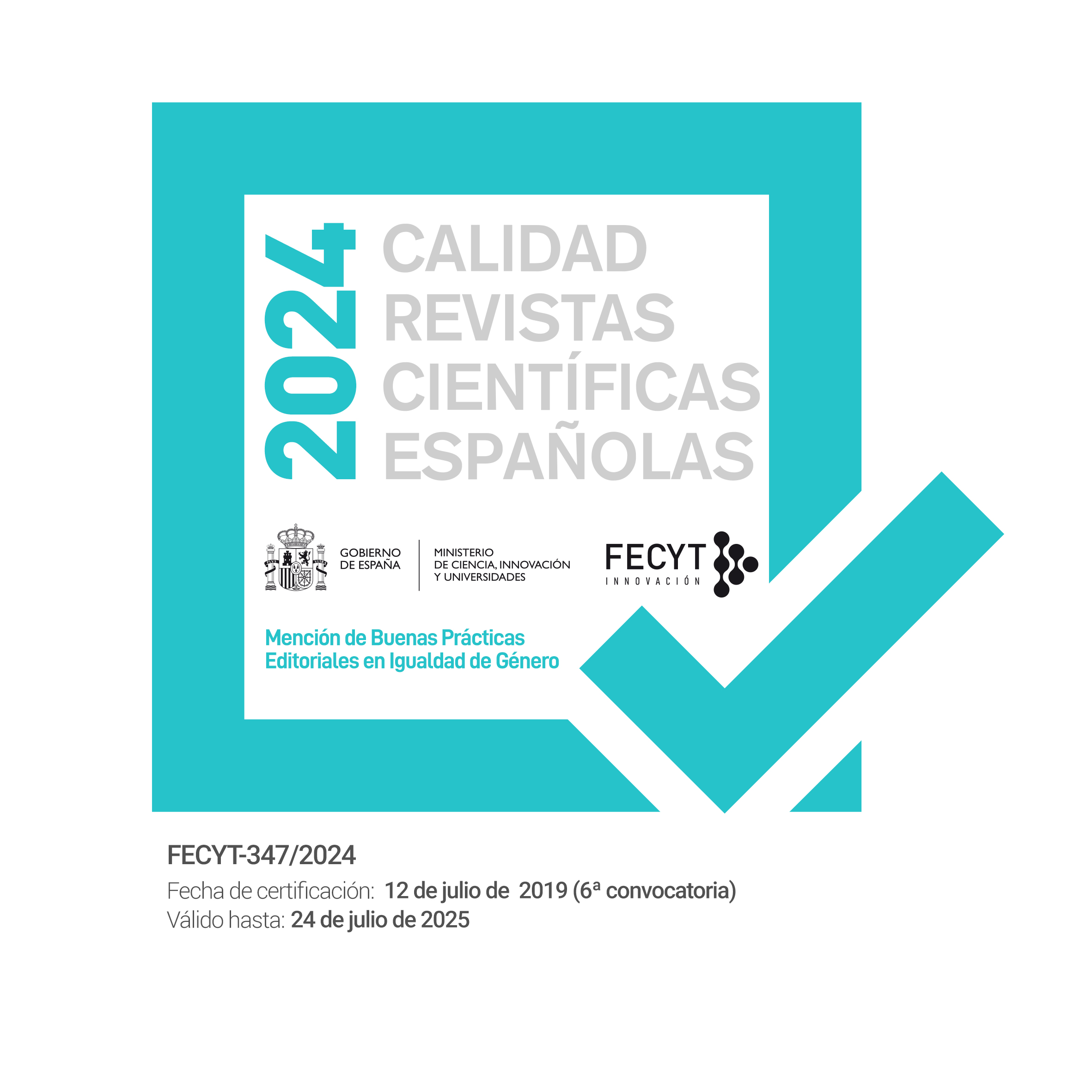Musical Instruments in the Sephardic Illuminated Bibles
Instrumentos musicales en las biblias hebreas ibéricas iluminadas
DOI:
https://doi.org/10.5944/etfvii.10.2022.32906Keywords:
Alfonso X el Sabio; Cantigas de Santa Maria; Iberian Hebrew Bibles; medieval Iberian music; medieval Iberian Jewish art; medieval Iberian Jewish music; paleographyAbstract
Some Iberian Hebrew Bibles produced from the thirteenth to the fifteenth century feature depictions of musical instruments within the full-page illustrations of the Temple implements. These instruments have been found to be similar to those in two contemporary Iberian Christian manuscripts: Cantigas de Santa Maria Codex E and Peter Comestor’s Historia Scholastica. The trumpets and ram’s horn appear next to one another in the Bibles and their appearance together is a unique feature in Jewish art. Also noteworthy is the fact that most of the trumpets have some gold or are entirely of gold or are gilded whereas the Temple’s and Tabernacle’s trumpets were specifically said to be made of pure silver. This article suggests that these two features reflect an attempt on the part of Iberian Jews to associate their music with that of the court of King Alfonso X and his heirs, as the illustrations imply that they and the king had shared musical roots.
Downloads
References
Bowles, Edmund E.: «Iconography as a Tool for Examining the Loud Consort in the Fifteenth Century», Journal of the American Musical Instrument Society 3 (1977), pp. 100-121.
Braun, Joachim: «Biblical Instruments: Shofar», Grove Music Online. Oxford Music Online, accessed October 8, 2017, http://www.oxfordmusiconline.com/subscriber/article/grove/music/52983.
Ferreira, Manuel Pedro: «The Stemma of the Marian Cantigas: Philological and Musical Evidence», Cantigueiros, 6 (1994), pp. 58-98.
Frojmovic, Eva: «Messianic Politics in Re-Christianized Spain: Images of the Sanctuary in Hebrew Bible Manuscripts», in Imagining the Self, Imagining the Other: Visual Representation and Jewish-Christian Dynamics in the Middle Ages and Early Modern Period, ed. Eva Frojmovic. Leiden, Brill, 2002, pp. 111-117.
Grossberg, Asher: «Zecher la-mikdash be-batey kneset kdumim», Tchumin, 15 (1994/1995) pp. 461-488.
Gutmann, Joseph: «The Messianic Temple in Spanish Medieval Hebrew Manuscripts», in The Temple of Solomon, Archaeological Fact and Medieval Tradition in Christian, Islamic and Jewish Art, ed. Joseph Gutmann. Missoula, MN, Scholars Press, 1976, pp. 127-128.
Gutmann, Joseph: «When the Kingdom Comes: Messianic Themes in Medieval Jewish Art», Art Journal, 27/2 (1967/1968), pp. 168-175.
HaCohen, Ruth: The Music Libel Against the Jews. New Haven, Yale University Press, 2013.
Hüttenmeister, Gil: «Synagogue and Beth Ha-Midrash and Their Relationship» («Beit ha-kneset ve-beit ha-midrash veha-zika benehem»). Cathedra, 18 (1981), pp. 37-49.
Kogman-Appel, Katrin, «Hebrew Manuscript Painting in Late Medieval Spain: Signs of a Culture in Transition», The Art Bulletin, 84/2 (June 2002), pp. 246-272.
Kogman-Appel, Katrin: Jewish Book Art Between Islam and Christianity: The Decoration of Hebrew Bibles in Medieval Spain. Leiden, Brill, 2004.
Kogman-Appel, Katrin: «The Messianic Sanctuary in Late Fifteenth-Century Sepharad: Isaac de Braga’s Bible and the Reception of Traditional Temple Imagery», in Between Jerusalem and Europe. Leiden, Brill, 2015, pp. 233-254.
Maimonides: Mishneh Torah hu ha-yad ha-hazaqa lerabbenu Moshe ben Maimon: Sefer Hashoftim: Hilkhot melakhim umilhamot. Jerusalem, Mercaz Harav, 1957.
Martinez, Jota: Instrumentarium musical alfonsi, Documentación, estudio, reconstrucción y praxis de los instrumentos musicales representados en la obra de Alfonso X. Spain, La Imprenta CG, 2021.
Montagu, Jeremy: «Shofar», Grove Music Online. Oxford Music Online, accessed October 8, 2017, http://www.oxfordmusiconline.com/subscriber/article/grove/music/25658.
Narkiss, Bezalel: «Pagan, Christian, and Jewish Elements in the Art of Ancient Synagogues», in The Synagogue in Late Antiquity. Philadelphia: American Schools of Oriental Research, 1987, pp. 183-188.
Nordström, Carl-Otto: «The Temple Miniatures in the Peter Comestor Manuscript in Madrid (Bibl. Nac., Cod. Res. 199)», Horea Saederblomianae, 6 (1964), pp. 54-81.
Offenberg, Sara: «Isaac Ibn Sahula and King Alfonso X: Possible Connections between the book Meshal Haqadmoni and the Cántigas de Santa Maria», Arts and Social Sciences Journal, 5:2 (2014), pp. 1-7.
Ovadiah, Asher: Mosaic Art in Ancient Synagogues in Israel from the 4th to the 7th Centuries («Omanut ha-psefas be-batey kneset atikim be-eretz-israel meha-me’a ha-revi’it ad ha-me’a ha-shvi’it»). Tel Aviv, Tel Aviv University Press, 1993.
Patton, Pamela A.: Art of Estrangement: Redefining Jews in Reconquest Spain. University Park, PA, Penn State University Press, 2012.
Revel-Neher, Elisabeth: Le témoignage de l’absence: les objets du sanctuaire à Byzance et dans l’art juif du XIe au XVe siècles. Paris, De Boccard, 1998.
Richler, Benjamin; Beit-Arié, Malachi: Hebrew Manuscripts in the Biblioteca Palatina in Parma, Catalogue. Jerusalem, Hebrew University of Jerusalem, Jewish National and University Library, 2001.
Rodov, Ilia: «Dragons: A Symbol of Evil in Synagogue Decoration?» Ars Judaica, 1 (2005), pp. 63-84.
Sage, Jack: «Alfonso el Sabio», Grove Music Online. Oxford Music Online, accessed October 10, 2017, http://www.oxfordmusiconline.com/subscriber/article/grove/music/00554.
Shaked, Guy: «The Jewish Attitude towards the Playing of Music in the Tripartite Mahzor», Cogent Arts & Humanities, 7:1 (2020), doi: https://10.1080/23311983.2020.1740539.
Weiss, Zeev and Netzer, Ehud: Promise and Redemption: A Synagogue Mosaic from Sepphoris (Havtahah ve-geulah: psefas beit-ha-kneset me-tzipori). Jerusalem, Israel Museum, 1996.
Published
How to Cite
Issue
Section
License
Copyright (c) 2022 Guy Shaked

This work is licensed under a Creative Commons Attribution-NonCommercial 4.0 International License.
Authors who publish in this journal agree to the following terms:
- Authors retain copyright and grant the journal right of the first publication with the work simultaneously licensed under a license Creative Commons Reconocimiento-NoComercial 4.0 Internacional that allows others to share the work with an acknowledgement of the work's authorship and initial publication in this journal.

- Authors are able to enter into separate, additional contractual arrangements for the non-exclusive distribution of the journal's published version of the work (e.g., post it to an institutional repository or publish it in a book), with an acknowledgement of its initial publication in this journal.
- Authors are permitted and encouraged to post their work online (e.g., in institutional repositories or on their website) prior to and during the submission process, as it can lead to productive exchanges, as well as to earlier and greater citation of the published work (See The Effect of Open Access).








